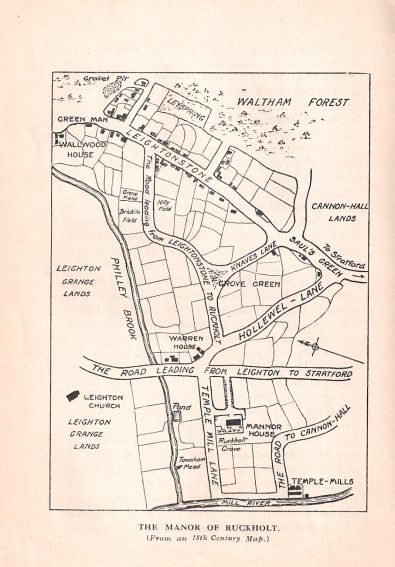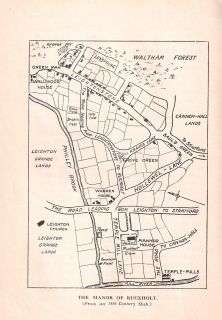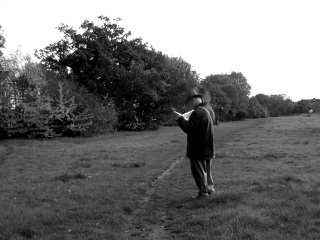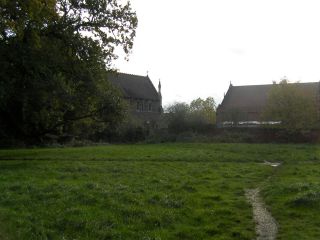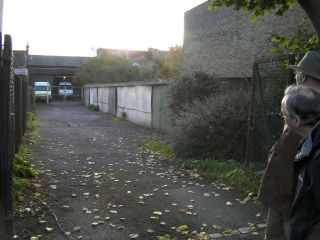I received a curious communication via Instagram which triggered a 10 year unsolved mystery involving a buried river in Upper Walthamstow. The message informed me of an incident a few years ago where a woman had seen some workmen investigating a leak in the area. They descended a set of steps beneath a manhole cover outside the flats in Bisterne Avenue that they said led down to a stream that appeared to run the length of the road. This immediately captured my interest and as soon as I looked up Bisterne Avenue on the map I knew I had to investigate further.
In 2009/10 I started researching the course of the Philley Brook (Fillebrook) – the buried river running beneath the streets of Leytonstone and Leyton for an episode of my radio show with Nick Papadimitriou on Resonance fm. The staff in the archives at Vestry House Museum in Walthamstow pulled out a collection of resources for me to study. There were the 19th Century ordnance survey maps that clearly showed the Philley Brook running down through the fields of Upper Leytonstone, beneath the railway line and onwards across Leyton High Road where there was a footbridge, and then to make its confluence with a smaller river at Collins Ferry on the River Lea. There were also newspaper reports spanning nearly 100 years mentioning the river and and efforts to deal with the flooding of the ‘Fillebrook Valley’ that only seemed to be resolved in the mid-1990’s. However the newspaper report in the Guardian and Gazette from May 1994 mentioned the source of the river not rising near the end of James Lane at Whipps Cross as in all the other sources and maps, but above Wood Street in Walthamstow. The only way to resolve this anomaly was on the ground.
Consequently, when I headed out with Nick in November 2010 to record our episode of Ventures and Adventures in Topography we started our quest in Wood Street, Walthamstow. Here in a narrow lane between some garages and the cricket ground we met a man who told us of the water running along this track. We followed it back to the high ground on the forest edge and there concluded that it must either be a separate stream altogether or perhaps an alternative source of the Philley Brook. In any case we had a rendezvous to keep with local historian David Boote in Leytonstone, the authority on the area and a person who knew the course of the river. We checked in on the documented source of the Philley Brook behind St. Andrew’s Church, Leytonstone and indeed it bore all the indicators of the source of a river. The ladies serving tea in the church confirmed that a river did indeed run beneath the ground near the church and recent building works behind the church had disrupted the watercourse and flooded parts of the church. David Boote then confirmed the course of the river as rising at the end of James Lane, as stated in the 19th Century documents at the Vestry House. Our detour to Walthamstow had been a red herring.
But it always bothered me that there was indeed some kind of buried river in Upper Walthamstow, unacknoweldged, unnamed, and as far as I could tell uncharted. The current lockdown gave me the chance to re-open this 10-year old cold case of the missing lost river of Walthamstow. I wrote it on my plan for YouTube videos – ‘The Lost River of Walthamstow’ – although I had no lost river, could find nothing online, nor on the old maps I’d found. The Instagram message changed everything – here was a confirmed sighting by water board staff bang in the vicinity of the reports from 2010. The hunt for the lost river of Walthamstow was on.

Forest Rise Walthamstow
Passing the wooded fringe on Forest Rise brought back memories of that November day with Nick 10 years ago. It was freezing cold and damp. Snow would arrive before broadcast day closing off the studio, meaning we had to pre-record in my box room and send via the internet in a foreshadowing the way a lot of radio has been produced during lockdown.
Working past St. Peter’s in the Forest I arrived at Bisterne Avenue. There were no major indicators of a buried river as such, but I now know that the manhole mentioned in the Instagram message was located behind the block of flats. Another person has also been in touch since the video was posted to YouTube confirming a buried stream running behind the flats.
At the end of the street I figured the stream could either follow the bend of Fyfield Road or flow directly down the hill. An unnaturally wide gap in the terrace opposite seemed to indicate the latter. I’d have to walk in a wide loop to get to Waverley Road on the other side of the houses and the railway line which gave me the opportunity to return to the laneway running parallel to Greenway Avenue where we’d met the man 10 years claiming the river ran behind his house. In the week before the walk somebody had sent me a series of maps from an architects office on which were marked underground rivers in London. One clearly showed the course of the Cran Brook which I’d walked last year. Another showed the Philley Brook flowing through Leytonstone and Leyton. But there in the corner of the map was another buried watercourse, rising on the far side of the cricket ground in Upper Walthamstow, arcing behind Greenway Avenue and then crossing Wood Street and picking up the route described in the report on the water works in the 1994 Gazette article. This appeared to be confirmation of the hunch we’d had that day, that a buried river ran through the area. I still had to somehow reconcile this with the stream rising in Bisterne Avenue.
Passing along Wood Street, past the brilliant covered market, I came to the bottom of Waverley Road which lined up with the gap in the houses opposite the end of Bisterne Avenue. This seemed consistent with the possible flow of the river. After posting the video to YouTube, a comment supported this hypothesis. The commenter said their house backed onto Waverley Road and flooding in a neighbour’s garden was confirmed as coming from ‘an underground river’.

I followed this course across Wood Street into Havant Road where just after St. Gabriel’s Church the road rises to Shernhall Street, placing the river running South beneath Turner Road. On the bend in the street, as Turner Road also rises towards the high ground, there was an alleyway potentially indicating the continuation of the buried river. I can’t quite describe the buzz of encountering this little passage when it looked as if I’d hit a dead end. Now the proposed route lines up with the watercourse marked on the 1840 map running South to Leyton and Leytonstone – at which point it is named on the map as the Phillebrook. Returning home from my first spontaneous walk sniffing out the course from the shape in the land, I was still unsure I’d found the elusive lost river of Walthamstow until I came across the 1840 map in the Victoria County History along with this blessed paragraph of text:
“West of Wood Street, flowing south to Leyton, was the watercourse which gave its name to Shernhall (‘filth stream’) Street, which it used to flood near Tinker’s bridge (Raglan Corner). In Leyton it was called the Phillebrook. It now runs underground.”
This was where I now found myself – West of Wood Street following the flow southwards towards Leyton. I continued the line of the river through the new development on Marlowe Road and past the large chapel on Valentin Road that I’d later find on the 1840 map. Zooming in on the photograph of the the architect’s map it appeared as if the river ran behind the chapel. Indeed once again a comment on the YouTube video offered further corroboration:
“Under the hall cica 1850 which backs on the Marlow Road estate, is a old boiler room, this always flooded following heavy rain, more often than not bringing with it a dead rat, and occasionally a live one. However the water did not smell and was considered to be ‘fresh’ rather than sewage. An electric sump pump had been fitted in the 1950’s to cope with it. I think this is good evidence for a subterranean stream.”
The stream then runs along Brooke Road – more likely named after local landowner Lord Brooke rather than the watercourse, before cutting behind the church on Oliver Road and running along the backs of houses on Shernhall Street (‘filth stream street’). An alleyway cuts through into Raglan Road and here I have to admit the way forward is inconclusive. On the one hand we have ‘Tinker’s Bridge at Raglan Corner’, and also a handwritten note by borough archivist Frederick Temple written some time in the early 20th Century recording that a local inhabitant had told him: ‘As a child in the 1880’s there were floods in the road by the Lord Raglan Public House. The beer barrels were floating about in the cellars’ . This would also suggest the river running along Eastern Road past the Lord Raglan. However the architect’s map shows it cutting across Raglan Road and crossing Lea Bridge Road and then flowing beneath the gardens of Eatington Road and Fulready Road. This makes no sense on the ground. The most likely course takes the Philley Brook (as it would now be called) through the car showroom forecourt on Lea Bridge Road and then beneath a long tract of open land behind West End Avenue to Whipps Cross Hospital. This route is partially supported by the 1994 report of pipes being laid in Peterborough Road.

James Lane Leytonstone
In any case the river almost certainly flows through the grounds of Whipps Cross Hospital where it crosses James Lane in low point in the land. The Leytonstone Fillebrook is said to rise ‘in Bury Field Farm’ at the end of James Lane. This was in the notes from the Vestry House and also in other older records. However it’s only now revisiting these notes I also see that the Victoria County History, in the section on Leyton, states:
‘The Phillebrook or Fillebrook, ‘Phepes Broke’ in 1537, entered Leyton from Walthamstow west of Whipps Cross, flowing south and south-west to join the Dagenham brook west of Ruckholts. In 1868 it was still open, but by 1904 it was piped from James Lane to the sewage works in Auckland Road; the last open stretch from West End Avenue to James Lane was closed in soon after.’
This open section of the Phillebrook / Fillebrook can be seen on the 1893 Ordnance Survey Map running from a pond to a footbridge in James Lane.
It was a special feeling to stand there in James Lane and consider that perhaps this 10-year mystery was partially put to rest. I’d say there’s evidence to suggest that the Philley Brook / Fillebrook (there’s also Phepe’s Brook) most likely has multiple sources – two in Upper Walthamstow that join to the West of Wood Street, and another on the high ground behind St. Andrew’s Church where the brook is known to flow still causing flooding in recent years. This branch joins the Walthamstow stream either in James Lane or Forest Road near the electricity substation, from where the conjoined river follows it’s well documented route through the streets of Leytonstone and Leyton. But as this article and the video demonstrates, there are still many questions to be answered about this beguiling lost river of Walthamstow.
Watch the walk along the continuation of the Philley Brook here
Here’s the next video in the series of Lost Rivers of Walthamstow – the Higham Hill Brook



























